Settings
Accessing Account Settings
The settings page can be accessed via the menu in the top right corner of your account. Here you can manage all aspects of your account, including your subscription, timesheet settings, user screens, group settings, custom fields, regional settings, tasks, absences, and more.
The following modules can be used on the settings page. If a module is not visible, you can add it to the page by clicking "Customize" in the top right menu and dragging and dropping the module you would like to add:
Absences: Create new absence types.
Account: Manage your subscription and integrations, download your data and invoices, etc.
Authorizations: Edit default authorizations for employees, managers, and other roles.
Custom Fields Settings: Create custom fields for any entity (customers, projects, employees, etc.).
Custom Module: Embed customizable static or dynamic content, including text, documents, images, video, or web pages using HTML.
Export Settings: Configure the format of your PDF exports, which can be used to create branded reports.
GDPR: Manage data and settings related to GDPR obligations for European countries.
Group Settings: Create groups, such as departments, locations, employee types, etc.
Holidays: Define public holidays.
Import: Bulk import all entities and additional data to Beebole rather than adding them manually.
Localization: Define regional settings.
On Time Settings: Configure the On Time feature to motivate employees to submit their timesheets.
People: Shows a list of all people in your company and can be used to add people.
Projects: Shows a list of all projects in your company and can be used to add projects.
QuickBooks Export and QuickBooks Settings: Modules used to export hours recorded in Beebole as a Timer IIF file and imported to QuickBooks for Windows.
Report: Run reports in a table format.
Schedule Assignment: Assign existing schedules to employees.
Schedule Settings: Define the default schedule and create advanced schedules.
Tasks: Create new tasks.
Timesheet Settings: Manage timesheet behavior, reminders, approvals, notifications, and more.
User Screens: Define new default screens for your users.
NOTE: Using these modules on the Settings page will display information and apply settings for all entities (people, projects, etc.) in your main company. You can also use these modules on a company branch page to apply different settings to that branch.
Different settings can be configured for multiple legal or geographical entities, such as corporate groups or multinationals with offices in various countries. For example, different currencies, date formats, and public holidays. To do so, use the settings modules on the individual company screens you want to change settings for. This will override the settings defined for the main company.
Managing Your Subscription
Manage your Beebole subscription using the Account module in the Settings screen. You can also use this module to enable API calls, manage your integration with Google Workspace, download audit trails and other timesheet data, and more.
By clicking Subscription, you can modify the number of users in your account, change your subscription period (up to one year), make payments, edit or remove payment info, and turn your account into a free account (for a single user).

To delete your Beebole account and all of its data, click on Delete this account. You will be asked to confirm, and all account administrators will receive an email notification. After seven days, all account data will be deleted from our system. Please note this deletion process cannot be reversed.
Download Billing Data
To download your account billing data, use the Account module in the Settings screen. Click Invoice History to download all invoices from your subscription payments. Invoices are also sent to you via email when payments are processed.
Download Audit Trails and Other Timesheet Data
You can download audit trails, SOX reports, project overviews, and other timesheet data by clicking Download your data in the Account module, which can be found in the Settings screen.
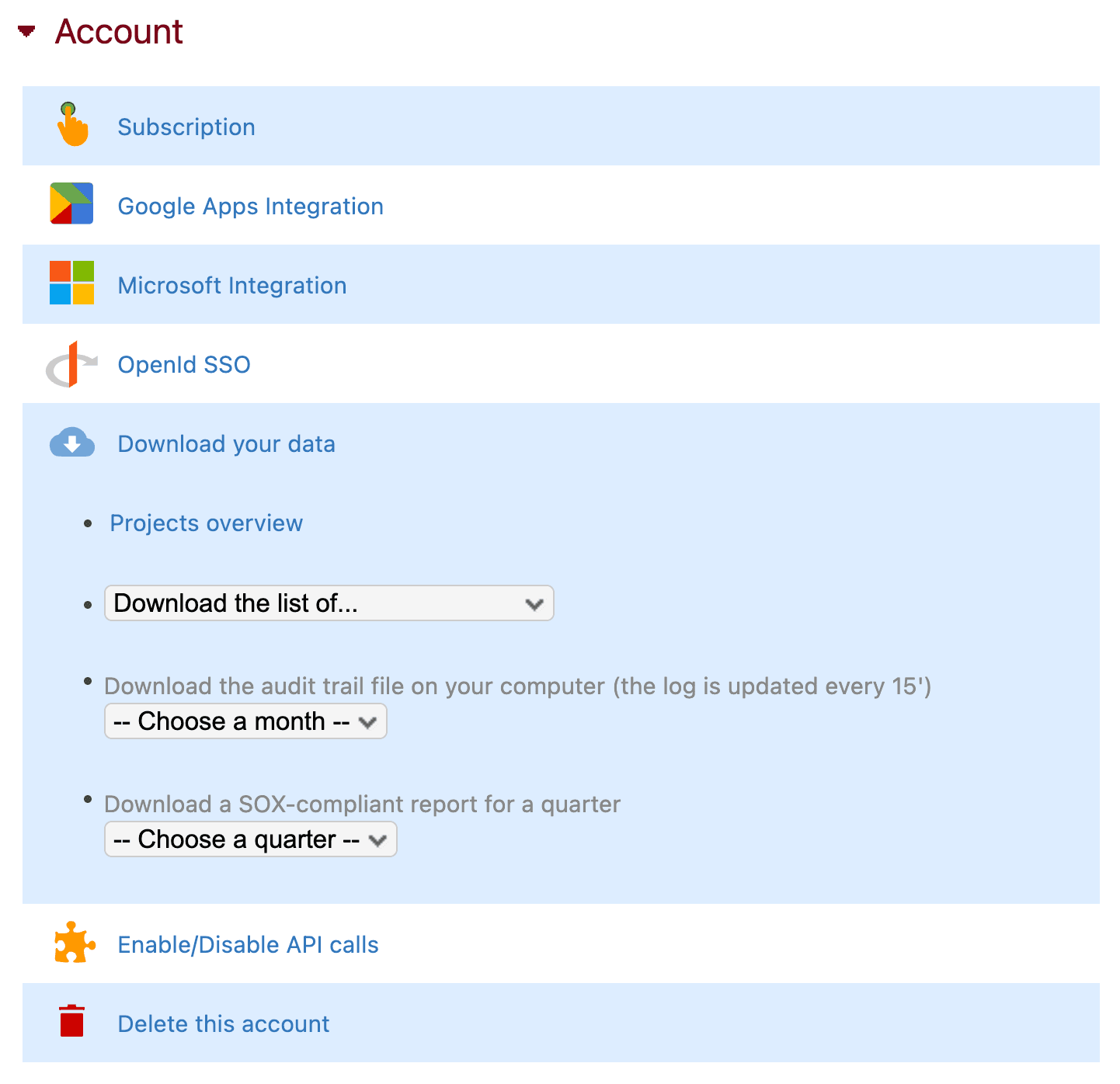
The Projects Overview will give you a summary of all companies, projects, and subprojects as well as their respective billing methods, tasks, project managers, and exclusive members. The data will appear in a separate browser window in HTML format.
Use the dropdown menu labeled "Download the list of..." to export data in a CSV format, which can be opened with any spreadsheet software.
Data that can be downloaded using this option include absences, billing methods, companies, projects, subprojects, custom fields, exclusive members, groups, IDs, people, project managers, schedule assignments, specific tasks, standard costs, tasks, teams, or work schedules.
Audit trail reports are monthly reports showing detailed information about changes made to time entries (the original entry, updates, submission, approval, deletion, actors, etc.). Audit trails are deactivated by default.
To activate audit trails, use the Timesheet Settings module in the Settings screen. Once activated, you can download an audit trail by selecting a month from the dropdown menu in the Account module. The data will be downloaded in a CSV format.
SOX reports are quarterly reports showing an overview of all approvals and submissions per week. SOX reports are deactivated by default. To activate them, use the Timesheet Settings module in the Settings screen.
Once activated, you can download a SOX report by selecting a period from the dropdown menu in the Account module. Data is downloaded in a CSV format.
Managing Google and Microsoft Integrations
If you already have a Beebole account, you can link it with your Google Workspace domain under the Google Apps Integration section of the Account module, which can be found in the Settings screen. Check our documentation to learn more about linking your account with Google Workspace.
If your company uses Microsoft 365 or Microsoft Azure, you can require users to sign in exclusively using the Microsoft SSO (Single Sign On) integration by going to the Microsoft Integration section of the Account module, which can be found in the Settings screen. In our documentation you will find more information about integrations with Microsoft 365 or Microsoft Azure.
Using OpenID SSO (Single Sign On)
You can use the OpenID SSO section of the Account module, available in the Settings screen, to enable Single Sign On with multiple SSO solutions such as OKTA, OneLogin, and more. The supported technology is OpenID Connect/OAuth2.0.
Enabling API Calls
You can enable or disable API calls to your Beebole account by going to the section Enable/Disable API calls in the Account module found in the Settings screen.
Take a look at Beebole's API documentation for more information.
Timesheet Settings Module
The Timesheet Settings module allows you to define the behavior of your employees' timesheets, reminders, approval workflow, etc., and to activate SOX reports or DCAA compliance.
The module can be found in the Settings screen, but you can also use it on individual company or employee pages if they require a unique configuration.
If you apply a unique configuration to certain people, you can download a list of their names in the Download your data section of the Account module.
To prevent employees from recording time prior to a specific date, select a date from the menu next to "Disable time entry before". This will also block changes to any existing time records from prior to that date.

Check "Enable Start and End time" to add these fields to your daily timesheet. Check "Mandatory" to require employees to record time using either the start time/end time fields or the timer. This means employees will not be able to record time by entering a duration. The limitation will not apply to recording absences.
Check "Enable the timer" to add the timer to your daily timesheet. Check "Mandatory" to require employees to record time using the timer. This means employees will not be able to record time by entering a duration or start and end times. The limitation does not apply to recording absences.
Use the Time format dropdown menu to record time in either a decimal format or time format (e.g. 2.5 or 2:30 for two hours and thirty minutes).
![]()
The minimum quantity of time accepted is just that: the minimum amount of time that will be accepted for a record in the timesheet.
If a shorter amount of time is entered, the time entry is automatically rounded up to the nearest multiple of the minimum. For example, if the minimum quantity defined is 0:30 (thirty minutes), an entry of 2:15 will automatically be adjusted to 2:30.
You can decide whether to allow overrun of an employee's scheduled time for the day or week. This will allow users to fill in more hours than the amount specified. If left unchecked, users will receive an error message when trying to add more hours than those defined in the Schedule Settings module.
Similarly, you may disable timesheet submissions if fewer hours have been tracked than those scheduled for the day or week. Users will not be able to submit hours if they do not meet the daily or weekly minimum requirements.

In the Timesheet Settings module you can also specify whether or not your company approves timesheets and, if so, configure the approval workflow and notifications.
Here you can toggle on and off notifications to team leaders, project managers, and employees when hours are submitted, approved, or rejected. You can also choose whether or not to copy the sender of a notification and whether to require comments when submitting timesheets.
Under the settings for approval notifications, you will see the option "Only Project Managers can approve their projects". If your organization has both project managers and team leaders, by default the project managers can approve hours recorded on their projects, while team leaders can approve hours recorded by the employees they manage (including hours done on projects).
Check this box if you want hours recorded on projects to be approved exclusively by project managers. Team leaders will still have to approve absences and any hours recorded on projects without a project manager.
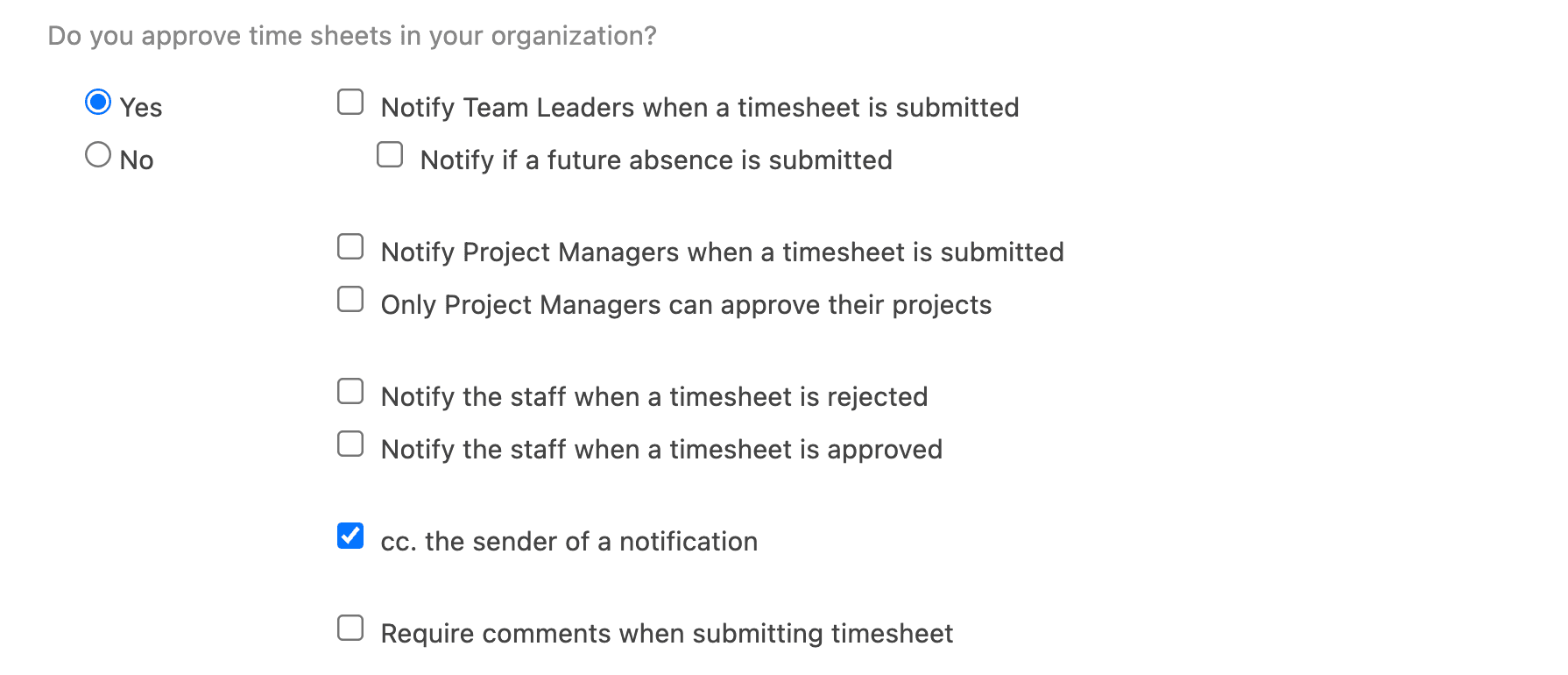
Underneath "Send a reminder to fill out timesheet every:" select if and when you would like to send email reminders to users to submit their timesheets. You can choose to send reminders at any time on a daily, weekly, biweekly (on the 1st and the 15th), or monthly (on the first or last day of the month) basis.
The time when reminders are sent is based on the time zone configured for your company, which you can modify in the Localization module.

Finally, you can enable or disable the enforcement of DCAA ownership and recording of audit trails by checking the corresponding boxes at the bottom of the Timesheet Settings module.
When you activate DCAA ownership, you ensure that employees are owners of their recorded time, meaning that project managers and team leaders cannot make any changes to submitted hours. Administrators will still be able to make changes to hours, although this should be done only in exceptional circumstances to comply with DCAA regulations.
By activating an audit trail of all timesheet updates, audit trail reports and SOX reports will become available in the Download your data section of the Account module.

Why Start and End Time Matter in Employee Time Tracking
Reasons you may want to require a timer for your team's time tracking (including legal compliance)
Creating Custom Fields
Custom fields can be applied to any entity (projects, customers, people, etc.) and allow you to expand on Beebole's standard fields with other values such as external IDs, project information, and more. The custom fields you create will also be available in reports.
You can add new custom fields using the Custom Fields Settings module, which appears by default in the Settings screen of account administrators. Just click "Add a custom field", give the new field a name, and then select which entity or entities it will be used for. You can edit or remove a custom field by hovering over it and clicking "Change" or "Delete".
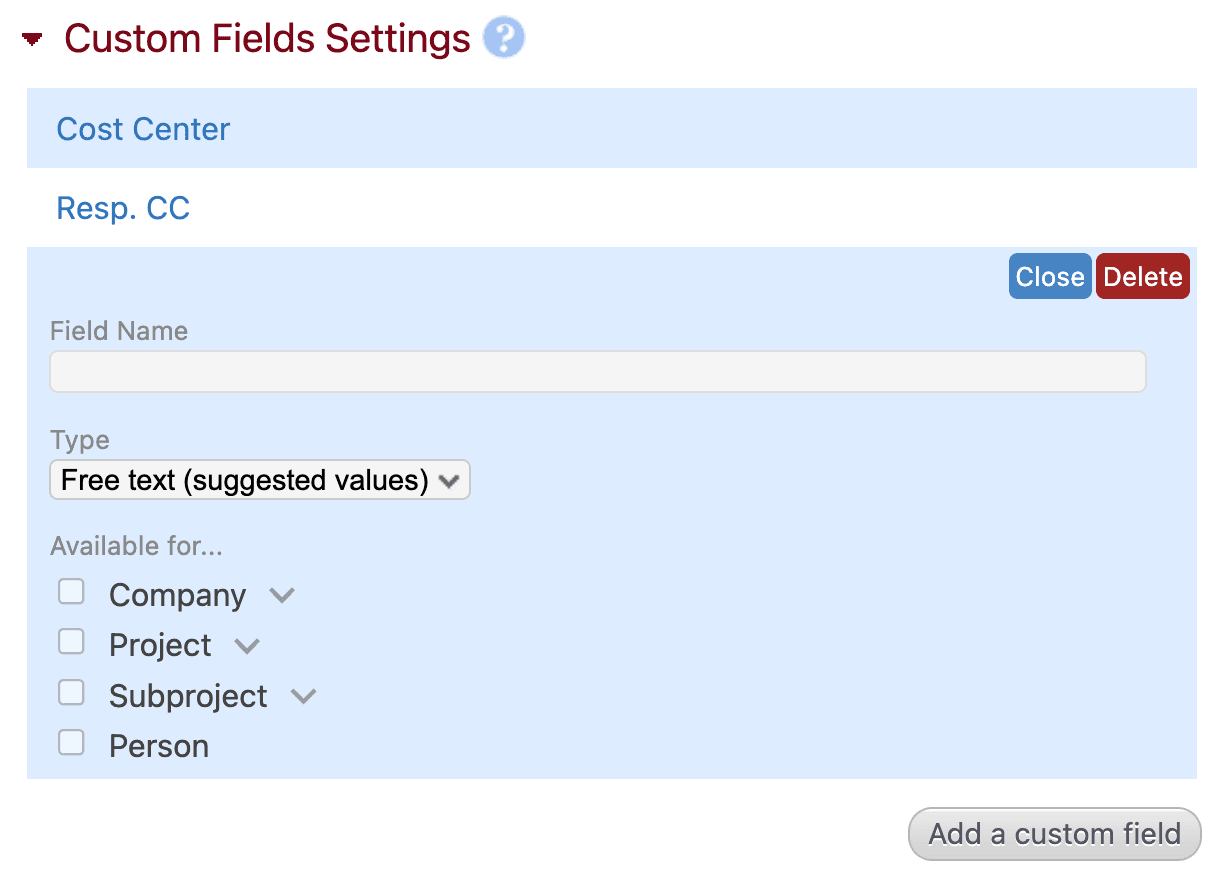
To assign values to custom fields, use the Custom Fields module on an entity's page. You can add the module to any entity page (projects, customers, people, etc.) by clicking "Customize" in the top right corner and dragging and dropping the module anywhere on the screen.
The custom fields you previously created for that entity will automatically appear here, and you can type their values into the fields in the right-hand column.

When adding a value, an auto-suggest dropdown menu will appear with the previously used values for that field. This is meant to help keep your data clean and to prevent errors or duplicates.
By default, the Custom Fields module is only available to administrators and team leaders, meaning that only they can assign values to custom fields. You can extend access to project managers, for example, using the Authorizations module.
To download a list of the custom field values that have been assigned to custom fields for each entity, go to the Download your data section of the Account module on your Settings screen. Select "Custom Fields" from the dropdown menu labeled "Download the list of...".
Custom fields can be used in reports in either the Reports or the Chart & Table modules. They will automatically become available to use as columns or filters.
Localization
The Localization module can be found in the settings screen and allows you to define your regional settings. You can also use this module on company branches or for individual employees that require a unique localization configuration. To add the module to a screen, click "Customize" in the top right corner and drag and drop the module anywhere on the page.
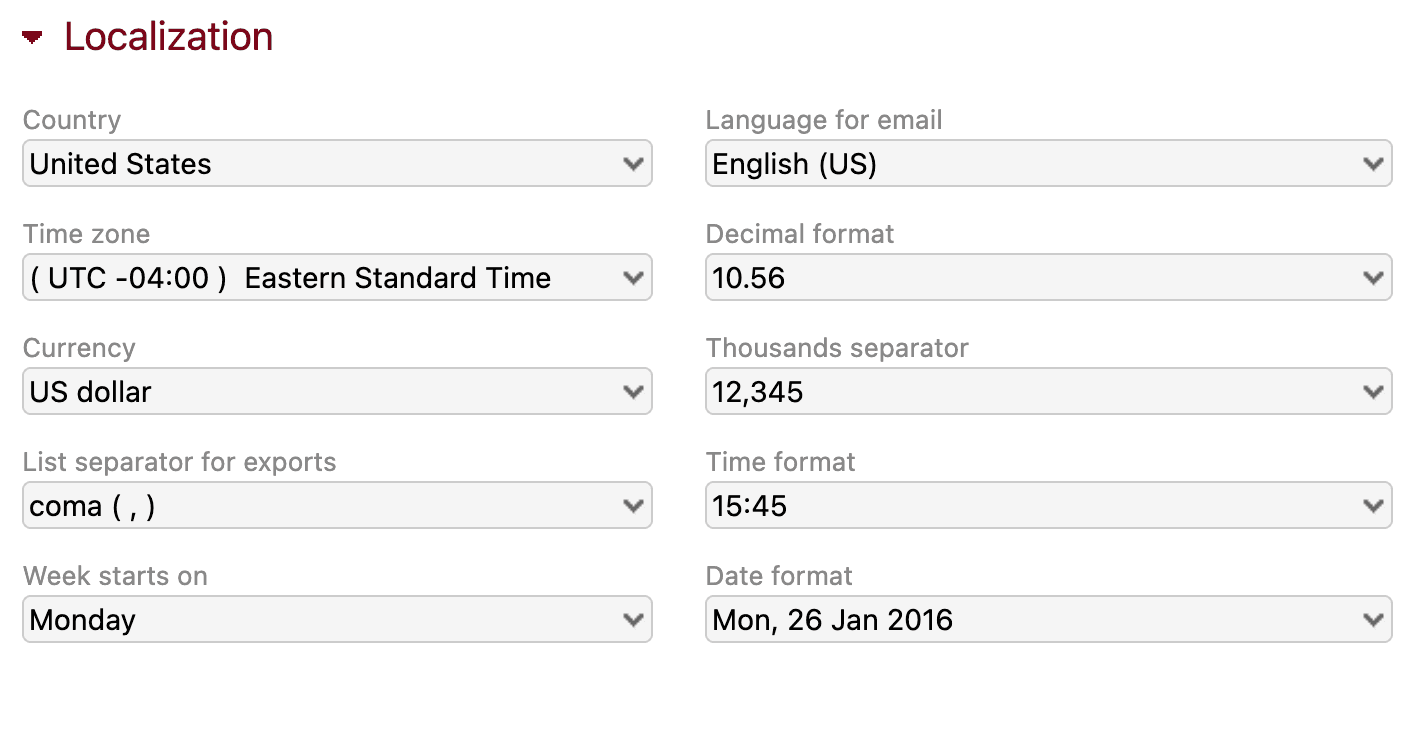
In this module you can configure:
The country where your company is based.
The language you would like used in emails sent by the system, such as reminders, user invitations, approval emails, etc. These emails can be further configured in the Timesheet Settings module.
The time zone where your company is based.
The decimal format you would like used for numbers in the interface, reports, and exports.
The main currency your company works in.
The thousands separator you would like used for numbers in the interface, reports, and exports.
The list separator ("," or ".") you would like used in the files that you export from Beebole depending on the regional configuration of your spreadsheet tool. When you open a CSV file exported from Beebole, if all data is shown in a single column you can try changing this parameter and re-exporting.
The time format (a 12-hour clock or 24-hour clock) you would like to use in the interface, reports, and exports.
The day that the working week starts on. This will change the way weeks are presented in your Timesheet module.
The date format you would like used in the interface, reports, and exports. This should coincide with the regional settings of your spreadsheet tool to ensure that dates are displayed correctly in exported files.
The non-working days (or weekends) for your company. Non-working days will be gray in the Timesheet and Team Calendar modules. They are also used for the On Time feature, as on time checks are not performed on non-working days.
GDPR
On our website you will find more information about Beebole's policy and practices relating to GDPR, or The General Data Protection Regulation.
The GDPR module will appear by default in the Settings screen of your Beebole account. As with all modules, the GDPR module can be minimized or dragged and dropped anywhere on the Settings screen.

In the module you can assign a data protection officer who will be contacted in the case of a data breach. Beebole is yet to experience a data breach, so you can rest assured that this is an extremely unlikely scenario.
However, if a breach occurs we will contact your company's designated data protection officer via email within 72 hours. If you have not designated a data protection officer, this email will be sent to all account administrators.
You can also use the GDPR module to download data for any user or employee. This is part of the GDPR "Right to Access", which is the right to receive confirmation as to whether or not personal data is being processed, as well as a copy of said data in an electronic format.
If an employee requests a copy of their Beebole data, you can download it via the GDPR module by selecting their name from the dropdown menu and then selecting the type of data you wish to download: basic data about the user, audit and log data, or timesheet related data.
Finally, in the GDPR module you are given the option to "delete audit trail logs older than 90 days". If you select this option, all audit trail data (trace data of who is recording, deleting, approving, and rejecting hours, etc.) will be saved for 90 days and then automatically deleted. Otherwise, this data will be saved indefinitely.
How to Customize Screens
You can customize your own Beebole interface by clicking "Customize" in the top right corner and dragging and dropping modules wherever you want them to appear on each screen. For example, you can add multiple Chart & Table modules to your home screen to create a personalized KPI dashboard featuring your most viewed reports.
To modify the default screens for different user groups (employees, team leaders, etc.) use the User Screens module, which is available in the Settings screen. Create a template and assign it to a group of users with the following steps (note, you must be an administrator):
Add a new user to the system and give it a name like "employee template", "team leaders screen", or whatever name will help you refer back to it later. For the user email, you can also use a placeholder like "employee_template" and select any user group from the dropdown menu.

Click "Send invitation by email" and copy the sign in link that appears in the green box.
Sign out of your own account and paste the copied link into your web browser. Create a password to log into the new template account.
Customize all of the screens that you would like to apply as a default for the given user group. You can customize any and all of the screens you want, and return to this template account whenever you want to update or change the default screens for this user group.
Sign out of the template account and sign back into your own administrator account.
Click "Settings" in the top right corner and add the User Screens module to the page.
Select the group from the first dropdown menu and select the template account from the second dropdown menu. All users in the selected group will now see the default screens that you configured in the template account.
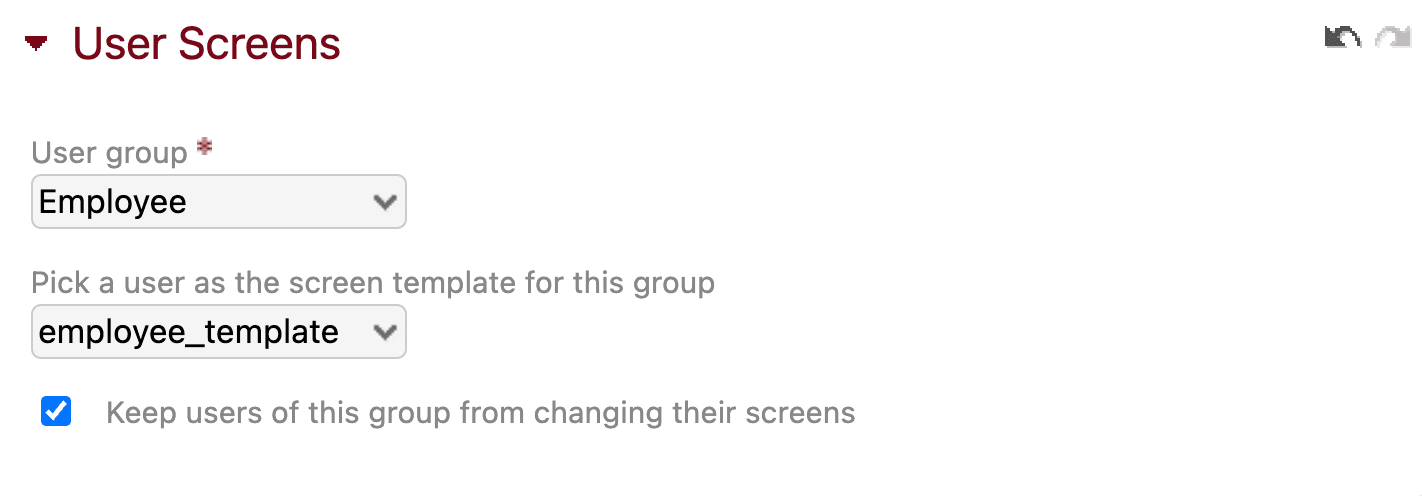
If you do not want users in a given group to be able to change their default screens, tick the box labeled "Prevent users of this group to change their screens".
You can repeat this operation as many times as you want for different user groups. Simply create multiple template accounts and add multiple User Screens modules to your Settings page.
NOTE:
If you allow users to edit their screens, any changes they make will take priority over the default template. Therefore, their screens will not be automatically updated when you update or edit the template. If a user wants to re-apply the default template, they should click "Customize" in the top right corner, select the "Your screens" tab and click "Reset all screens".
You must deactivate template accounts to prevent them from being included in your subscription. To do so, go to the page for the template account and click "Deactivate" in the Person Details module and then click "Activate" in the User Details module.
Importing Data
You can bulk import all entities and additional data to Beebole rather than adding them manually using the Import module. Specifically, the module can be used to import the following:
To import data:
From the dropdown menu, select which file or type of information you would like to import.
Click the link that appears that reads "Download the template to your computer". This will download a CSV file with the correct columns and formatting required to import your data to Beebole. Alternatively, you can use the Google Sheet links provided above and make a copy of the spreadsheet.
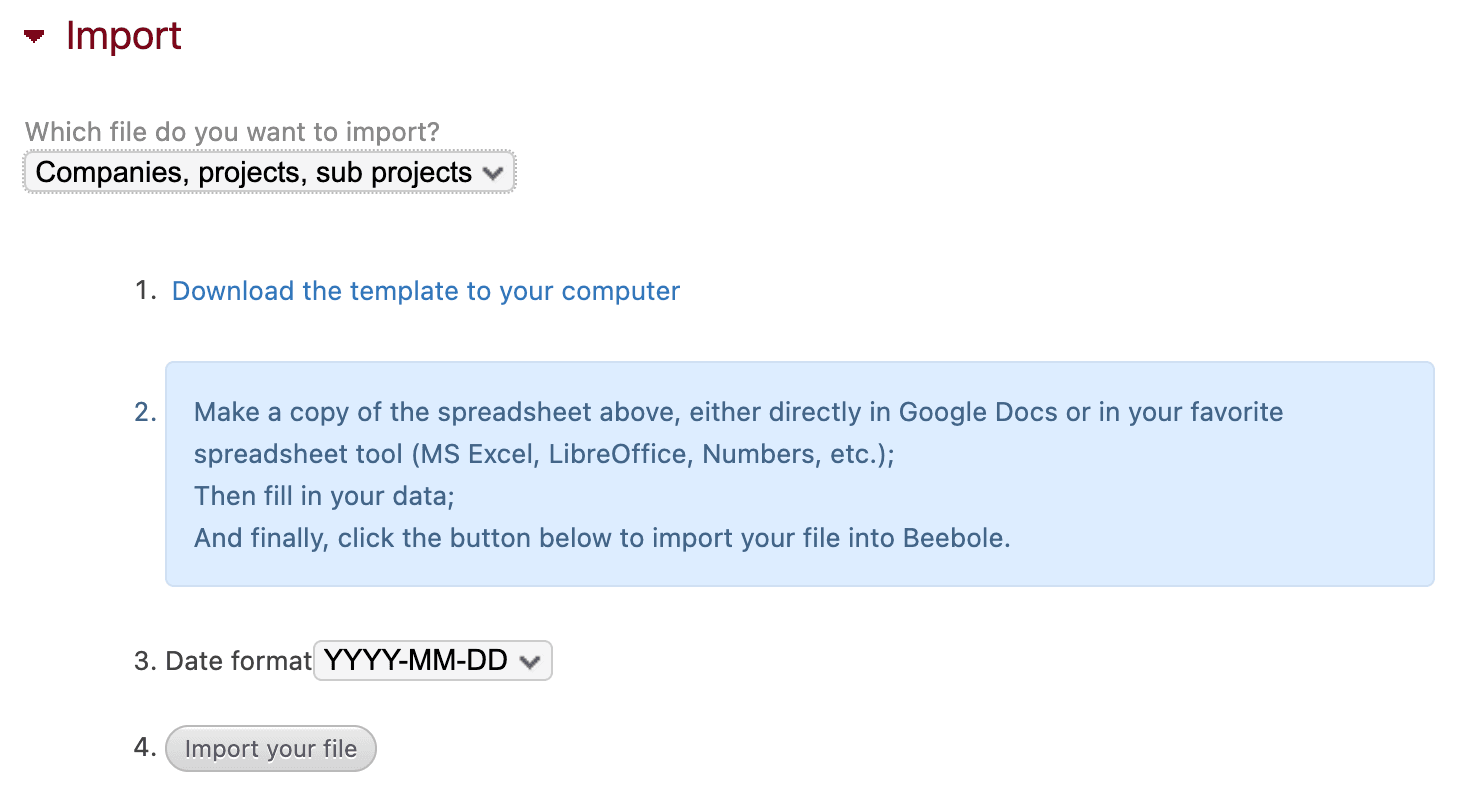
You'll see that some information is already added to the spreadsheet as an example. Where there is an orange corner on a header box, mouse over it to see tips or suggestions.
Fill in and save your data. Columns that are flagged as "**Optional**" may be left blank, but note that there is a hierarchy to the data. This means that if you import projects, for example, you also need to fill out the column for companies. If you import subprojects, you need to fill out the column for projects.
Go back to the Import module and select the date format of your spreadsheet. Then click "Import your file".
To undo your last import, again go to the Import module. Here you'll find a summary of the most recent import, including any errors or notifications. Successfully imported data appears in green. Click the "Undo the last import" button.
NOTE:
When importing data that already exists in your Beebole account, be sure the spelling matches exactly, otherwise, new entities will be created.
We recommend starting a new import with just a few lines, especially if it's your first time using the module. This way you can check that the information is correct before importing large amounts of data.
Other Settings
You can read more about other modules available on the Settings screen by visiting the following links.
